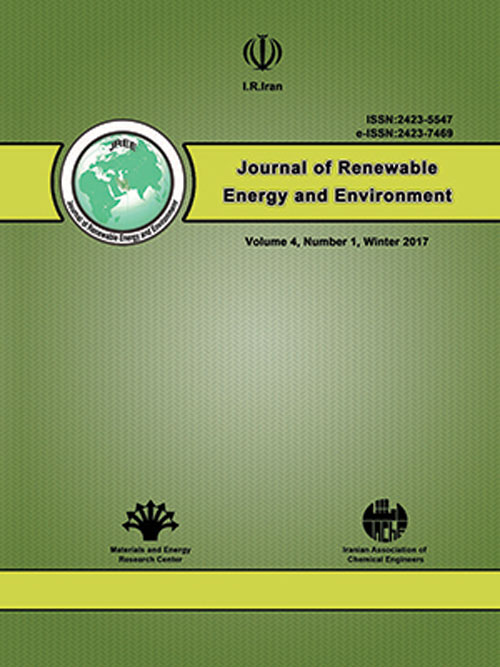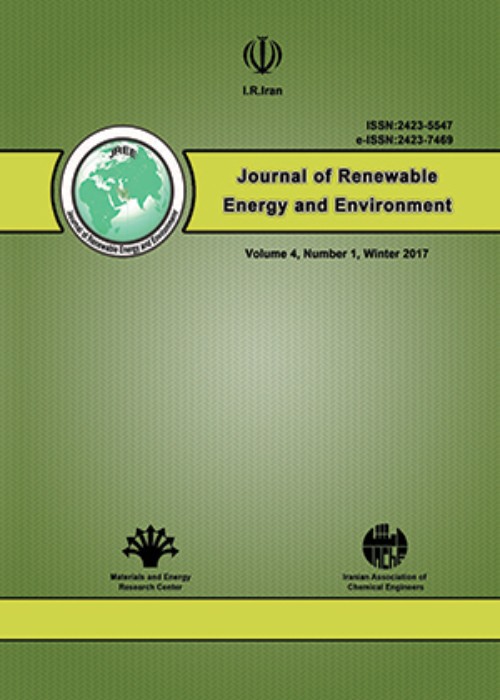فهرست مطالب

Journal of Renewable Energy and Environment
Volume:5 Issue: 3, Summer 2018
- تاریخ انتشار: 1397/05/31
- تعداد عناوین: 6
-
-
Pages 1-9
Traditional fossil fuels lead to environmental problems and are also depleting. A significant portion of global energy consumption is due to building’s air conditioning. Nowadays there is a great attention toward renewable and sustainable energy sources to support the buildings energy requirements. In this study, a solar cooling machine was designed for a three-floor residential building under a hot and arid climate. At first, thermal loads of the building were calculated using Carrier software. Changes in the material and color of the exterior walls and the windows type were made to reduce the heat transfer coefficient and to get an optimized design. Results revealed that about 37% maximum heating load reduction and 12% maximum cooling load reduction can be achieved using the optimum design. On the base of the maximum cooling load and also considering safety factor, a single effect LiBr-water solar absorption chiller was designed for the optimized designed building. Two different scenarios were suggested using two types of flat plate and evacuated tube collectors. Results reported that in the case of evacuated tube collector the net collector area of 254.18 m2 was sufficient to supply the cooling power. Implementing flat plate collectors would result in occupying an area of 398.5 m2. Regarding the limitation of total area of the roof and efficiency issues, the evacuated tube collector was the best option.
Keywords: Building Energy, Solar energy, Absorption Solar Chiller, optimization -
Pages 10-26According to the previous pieces of research, the building sector consumes about 40 % of total yield energy and produce one-third of GHG pollution emission. This point shows the significant potential in two aspects of energy optimization and pollution reduction in this field. The purpose of this research as a case study is to construct a residential building and develop the paths for reaching a zero-energy building, considering GHG emissions in the climate of Tehran, Iran. In thirty scenarios of this study, solar panels, solar water heaters, ground source heat pumps, and combined heat and power generators were selected to provide the required power and energy in the building. All three passive, single active, and hybrid active scenarios were defined and analyzed with respect to technical and economic factors. In all of the defined scenarios, the conditions are two-folded: (a) considering the effect of national profits, fuel saving, and pollution reduction and (b) without considering them so that the results would become more realistic. In the end, three different types of conclusions were made with respect to macro-engineering, energy, and economic perspectives. Statistical conclusions based on a questionnaire filled by 50 people and the perspective of achieving NZEB definition are presented.Keywords: Zero-energy Building, PV, GSHP, CHP, Solar Water Heater, AHP, Hybrid Generation Systems
-
Pages 27-41Using a variety of solar power plants is one of the solutions governments use to respond to energy and sustainable development needs. While Iran has a strong potential for using solar energy, the application of solar energy, especially through PV technology, has been limited due to the country’s richness of fossil fuels and their low prices. Therefore, it is important to adopt effective strategies and policies to promote the development and application of this technology. The purpose of this study is to identify factors affecting the use of photovoltaic technology in Iran. To this end, 142 factors were first identified through a comprehensive review of the literature. Then, all of these factors were prioritized and categorized by “semi-structured interview” with 15 energy policy experts. The “content analysis” of the experts’ opinions showed that only 59 of these factors were considered important at the sectorial level for Iran. Based on the same content analysis, a conceptual framework for the application of decentralized photovoltaic power plants in Iran was developed. The framework shows that 10 generic categories of factors should be considered by policy-makers at the solar energy sector to promote PV technology application in Iran. They include policy factors, institutional factors, finance and budgeting factors, system economy factors, macroeconomic factors, socio-cultural factors, human resource factors, factors influencing capabilities of industries, technological and related infrastructural factors, geographical, climatic and environmental factors, and foreign political factors. It is also emphasized that all these categories should be considered at three levels: industry (electricity industry) level, national level, and international level. Thus, renewable energy policy-makers in Iran should take into account all means that influence these factors in order to improve the conditions for decentralized photovoltaic technology application.Keywords: Solar energy, Photovoltaic Technology, PV, distributed generation, Policy Framework
-
Pages 42-52Fuel cell-based hybrid cycles that include conventional power generators have been created to modify energy performance and output power. In the present paper, integrated biomass gasification (IBG)-molten carbonate fuel cell (MCFC)-gas turbine (GT) and steam turbine (ST) combined power cycle is introduced as an innovative technique in terms of sustainable energy. In addition, biomass gasification has been explained and shown able to supply the required fuel to the energy generators to compensate for the consumption consequences of fossil fuels. In this system, a molten carbonate fuel cell generates electricity from syngas produced by biomass gasification. In addition, a gas cleaning process prepares adequate treatment before consumption in the fuel cell. Furthermore, for the justification of this system as a combined heat and power (CHP) cycle, a considerable amount of produced heat in the proposed process generates power in GT and ST bottoming cycles. Due to the energy targeting, modeling and simulation of the presented system were fulfilled by the Cycle-Tempo software, and the results showed about 42 MW output power and total efficiency of around 83 %. Further to that, parametric studies represented the durability of the generated power against ambient temperature variations. Finally, changes in total power and efficiency due to the fluctuation of the moisture content of biomass, pressure ratio, and inlet temperature of GT have also been demonstrated.Keywords: Biomass Gasifier, Molten Carbonate Fuel Cell, Gas turbine, Steam Turbine, Hybrid system
-
Two-Stage Stochastic Day-Ahead Market Clearing in Gas and Power Networks Integrated with Wind EnergyPages 53-59
The significant penetration rate of wind turbines in power systems made some challenges in the operation of the systems such as large-scale power fluctuations induced by wind farms. Gas-fired plants with fast starting ability and high ramping can better handle natural uncertainties of wind power compared to other traditional plants. Therefore, the integration of electrical and natural gas systems has great potential of enhancing the flexibility of power systems to incorporate more renewable power sources such as wind turbines. In this area, the uncertainty associated with wind speed has a meaningful impact on the optimal management of the generation units in power grids. This study proposes a stochastic market-based model for clearing of energy in interconnected power and gas systems with integration of wind power. Stochastic programming is developed for studying the uncertainty of wind power production using a normal distribution function in a two-stage model. It should be remarked that the proposed two-stage model covers the uncertainty of wind power generation and load demand in real-time dispatch determining the hourly scheduling of units in the first stage. It is expected that the operation cost of the integrated networks, local marginal pricing of the gas and power, and the load shedding will be increased by an increase in the residential gas load. The investigations showed a 4.2% increase of total operation cost of the integrated power and gas system by a 5% increase in the residential gas load.
Keywords: Day-ahead market clearing, Two-stage stochastic programming, integrated power, natural gas networks, wind power -
Pages 60-63
Accurate lifetime prediction of lithium-ion batteries is a great challenge for the researchers and engineers involved in battery applications in electric vehicles and satellites. In this study, a semi-empirical model is introduced to predict the capacity loss of lithium-ion batteries as a function of charge and discharge cycles, operational time, and temperature. The model parameters are obtained by minimizing the prediction errors of experimental capacity loss for each charge/discharge cycle at 25 oC, 35 oC, and 45 oC.The optimum values of the model parameters are obtained using genetic algorithm, one of the optimization tools in Matlab software. The model accurately predicts the capacity loss of lithium-ion battery for more charge and discharge cycles at 25 °C with an average error of 4 %. The mentioned cycles are used only to validate the prediction.
Keywords: Lithium-Ion Battery, Capacity Loss, Lifetime Prediction, Cycle-Life, Operational Time


